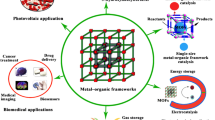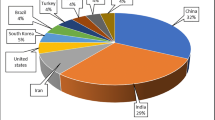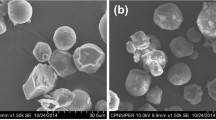Abstract
The present work deals with encapsulation of fragrance molecule in inorganic nanocontainers substrate and investigation of its prolonged release at different pH condition. The nanocontainers used were aluminosilicate clay (Halloysite) having cylindrical shape with outside diameter in the range of 30–50 nm, 15 nm lumen and length equal to 800 ± 300 nm. Rosewater absolute was used as a sample fragrance for loading in nanocontainer and delivery purpose. The fragrance loaded nanocontainers were coated with a thin layer of polyelectrolyte i.e. Polyacrylic Acid (PAA). The structural characteristics of prepared nanocontainers were determined by using Fourier Transform Intra-red Spectroscopy (FTIR), Thermal Gravimetric Analysis (TGA) and UV spectroscopy analysis. Release of fragrance molecules in the aqueous medium was monitored for 24 h. The fragrance release was found to be responsive as the amount of fragrance release increases with increase in pH value from 3 to 7. Fragrance release has been studied by using various permeation kinetic models such as zero order, first order, Hixson–Crowell, Higuchi, Korsmeyer–Peppas and Hopfenberg models. Korsemyer–Peppas shows the best fit (R2 = 0.9544) compared to other kinetic model for the release of fragrance from nanocontainers.












Similar content being viewed by others
References
M.L. Zheludkevich, J. Tedim, M.G.S. Ferreira, “Smart” coatings for active corrosion protection based on multi-functional micro and nanocontainers. Electrochim. Acta 82, 314–323 (2012)
E. Fleige, M.A. Quadir, R. Haag, Stimuli-responsive polymeric nanocarriers for the controlled transport of active compounds: concepts and applications. Adv. Drug Deliver. Rev. 64, 866–884 (2012)
M. Zhou, T.S.H. Leong, S. Melino, F. Cavalieri, S. Kentish, M. Ashokkumar, Sonochemical synthesis of liquid-encapsulated lysozyme microspheres. Ultrason. Sonochem. 17, 333–337 (2010)
D.G. Shchukin, K. Kohler, H. Mohwald, G.B. Sukhorukov, Gas-filled polyelectrolyte capsules. Angew. Chem. Int. Edit. 44, 3310–3314 (2005)
D.G. Shchukin, D.A. Gorin, H. Mohwald, Ultrasonically induced opening of polyelectrolyte microcontainers. Langmuir 22, 7400–7404 (2006)
D. Horák, M. Trchová, M.J. Bene, M. Veverk, E. Pollert, Monodisperse magnetic compo site poly(glycidyl methacrylate)/La0.75Sr0.25MnO3 microspheres by the dispersion polymerization. Polymer 51, 3116–3122 (2010)
F. Tiarks, K. Landfester, M. Antonietti, Preparation of polymeric nanocapsules by miniemulsion polymerization. Langmuir 17, 908–918 (2010)
L. Sanchez, P. Sanchez, A. De-Lucas, M. Carmona, J.F. Rodriguez, Microencapsulation of phase change materials with a polystyrene shell. Colloid Polym. Sci. 285, 1377–1385 (2007)
S.H. Sonawane, B.A. Bhanvase, A.A. Jamali, S.K. Dubey, S.S. Kale, D.V. Pinjari, A.B. Pandit, Improved active anticorrosion coatings using layer-by-layer assembled ZnO nanocontainers with benzotriazole. Chem. Eng. J. 189–190, 464–472 (2012)
B.A. Bhanvase, Y. Kutbuddin, R.N. Borse, N. Selokar, D.V. Pinjari, S.H. Sonawane, A.B. Pandit, Ultrasound assisted intensification of calcium zinc phosphate pigment synthesis and its nanocontainer for active anticorrosion coatings. Chem. Eng. J. 231, 345–354 (2013)
S.Q. Li, J.E. Lewis, N.M. Stewart, L. Qian, H.J. Boyter, Effect of finishing methods on washing durability of microencapsulated aroma finishing. J. Textile Inst. 99, 177–183 (2008)
N. Gordon, Microencapsulation in textile finishing. Rev. Prog. Color. Rel. Top. 321, 57–64 (2001)
G. Kyle, Evaluating the effectiveness of aromatherapy in reducing levels of anxiety in palliative care patients: results of a pilot study. Complement. Ther. Clin. Pract. 12, 148–155 (2006)
T. Tree-udom, S.P. Wanichwecharungruang, J. Seemork, S. Arayachukeat, Controlled release systems with physical and chemical barriers. Carbohyd. Polymers. 86, 1602–1609 (2011)
O. Tzhayik, A. Cavaco-Paulo, A. Gedanken, Fragrance release profile from sonochemically prepared protein microsphere containers. Ultrason. Sonochem. 19, 858–863 (2012)
B. Peña, C. Panisello, G. Aresté, R. Garcia-Valls, T. Gumí, Preparation and characterization of polysulfone microcapsules for fragrance release. Chem. Eng. J. 179, 394–403 (2012)
P. Wang, D. Wang, T. Xie, H. Li, M. Yang, X. Wei, Preparation of monodisperse Ag/Anatase TiO2 core–shell nanoparticles. Mater. Chem. Phy. 109, 181–183 (2008)
S. Martinez-Gallegos, S. Bulbulian, Effects of γ radiation on chromate immobilization by calcined hydrotalcites. Clay. Clay. Min. 52, 650–656 (2004)
A. Corma, V. Fornes, F. Rey, Delaminated zeolites: an efficient support for enzymes. Adv. Mat. 14, 71–74 (2002)
Y.M. Lvov, D.G. Shchukin, H. Mohwald, R.R. Price, Halloysite clay nanotubes for controlled release of protective agents. ACS Nano 2, 814–820 (2008)
R.R. Price, B.P. Gaber, Y.M. Lvov, In-vitro release characteristics of tetracycline HCl, khellin and nicoti-namide adenine dineculeotide from halloysite. A cyclindrical mineral. J. Microencap. 18, 713–722 (2001)
S.R. Levis, P.B. Deasy, Characterisation of halloysite for use as a microtubular drug delivery system. Int. J. Pharma. 243, 125–134 (2002)
S.R. Levis, P.B. Deasy, Use of coated microtubular halloysite for the sustained release of diltiazem hydrochloride and propranolol hydrochloride. Int. J. Pharm. 145, 145–157 (2003)
E. Abdullayev, R. Price, D. Shchukin, Y. Lvov, Halloysite tubes as nanocontainers for anticorrosion coating with benzotriazole. Appl. Mater. Interf. 1, 1437–1443 (2009)
D.V. Andreeva, D.G. Shchukin, Smart self-repairing protective coatings. Mater. Today 11, 24–30 (2008)
R. Liu, B. Zhan, D. Mei, H. Zhang, J. Liu, Adsorption of methyl violet from aqueous solution by halloysite nanotubes. Desalination 268, 111–116 (2011)
W. Jinhua, Z. Xiang, Z. Bing, Z. Yafei, Z. Rui, L. Jindun, C. Rongfeng, Rapid adsorption of Cr(VI) on modified halloysite nanotubes. Desalination 259, 22–28 (2010)
R. Zhai, B. Zhang, L. Liu, Y. Xie, H. Zhang, J. Liu, Immobilization of enzyme biocatalyst on natural halloysite nanotubes. Catal. Commun. 12, 259–263 (2010)
A.B. Lokhande, S. Mishra, R.D. Kulkarni, J.B. Naik, Influence of different viscosity grade ethylcellulose polymerson encapsulation and in vitro release study of drug loaded nanoparticles. J. Pharmacy Res. 7, 414–420 (2013)
J. Suksaeree, P. Boonme, W. Taweepred, G. Ritthidej, W. Pichayakorn, Characterization, in vitro release and permeation studies of nicotine transdermal patches prepared from deproteinized natural rubber latex blends. Chem. Eng. Res. Des. 90, 906–914 (2012)
B.A. Bhanvase, D.V. Pinjari, P.R. Gogate, S.H. Sonawane, A.B. Pandit, Synthesis of exfoliated poly(styrene-co-methyl methacrylate)/montmorillonite nanocomposite using ultrasound assisted in situ emulsion copolymerization. Chem. Eng. J. 181–182, 770–778 (2012)
C.G. Varelas, D.G. Dixon, C. Steiner, Zero-order release from biphasic polymer hydrogels. J. Control. Release 34, 185–192 (1995)
A. Silvina, M. Bravo, C. Lamas, J. Claudio, In vitro studies of diclofenac sodium controlled —release from biopolymeric hydrophillic matrices. J. Pharm. Pharm. Sci. 5, 213–219 (2002)
M.A. Hadi, A.S. Rao, S. Martha, Y. Sirisha, P.U. Chandrika, Development of a floating multiple unit controlled release beads of zidovudine for the treatment of AIDS. J. Pharm. Res. 6, 78–83 (2013)
P. Costa, J.M. Lobo, Modeling and comparison of dissolution profiles. European J. Pharm. Sci. 13, 123–133 (2001)
P.L. Ritger, N.A. Peppas, A simple equation for description of solute release I. Fickian and non-fickian release from non-swellable devices in the form of slabs, spheres, cylinders or discs. J. Control. Release 5, 23–36 (1987)
V.N. Ravella, R.R. Nadendla, N.C. Kesari, Design and evaluation of sustained release pellets of aceclofenac. J. Pharm. Res. 6, 525–531 (2013)
S. Bordeepong, D. Bhongsuwan, T. Pungrassami, T. Bhongsuwan, Characterization of halloysite from Thung Yai District, Nakhon Si Thammarat Province, in Southern Thailand, Songklanakarin. J. Sci. Tech. 33, 599–607 (2011)
S.H. Sonawane, P.L. Chaudhari, S.A. Ghodke, M.G. Parande, V.M. Bhandari, S. Mishra, R.D. Kulkarni, Ultrasound assisted synthesis of polyacrylic acid–nanoclay nanocomposite and its application in sonosorption studies of malachite green dye. Ultrason. Sonochem. 16, 351–355 (2009)
A.K. Panda, B.G. Mishra, D.K. Mishra, R.K. Singh, Effect of sulphuric acid treatment on the physico-chemical characteristics of kaolin clay. Colloids Surf. A 98, 98–104 (2010)
R.W. Korsmeyer, R. Gurny, E.M. Doelker, P. Buri, N.M. Peppas, Mechanism of solute release from porous hydrophilic polymers. Int. J. Pharm. 15, 25–35 (1983)
Author information
Authors and Affiliations
Corresponding author
Rights and permissions
About this article
Cite this article
Ghodke, S.A., Sonawane, S.H., Bhanvase, B.A. et al. Studies on Fragrance Delivery from Inorganic Nanocontainers: Encapsulation, Release and Modeling Studies. J. Inst. Eng. India Ser. E 96, 45–53 (2015). https://doi.org/10.1007/s40034-015-0059-z
Received:
Accepted:
Published:
Issue Date:
DOI: https://doi.org/10.1007/s40034-015-0059-z




